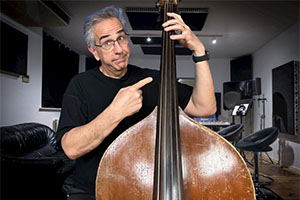Part of learning bass is understanding your role in the big picture
By Jon Liebman
July 21, 2023
As bass players, it’s been drilled into us from day one that in nearly every case, we’re supposed to play the root of the chord on the downbeat whenever a new chord is introduced.
Well… maybe that’s not so true after all.
Whaaaat???
You mean you’ve been lying to me this whole time???
“But Jon,” you say, “you’ve drilled into us from the beginning that we need to play the root on the downbeat, practically 99% of the time!”
Yes, that’s the generally accepted – and expected – practice for bass players. There’s even an old adage that says a bass player will never get fired for playing too many roots.
But that principle deserves a closer look.
Warning: the remainder of this blog should be read with caution.
The other side of the coin
I recently had a fascinating conversation with jazz bass legend Ron Carter, published as this week’s FBPO interview. During our discussion, I asked Maestro how he goes in search of “right” notes, given the framework in which we bass players need to follow, including playing the root of the chord on the downbeat.
Right off the bat, he didn’t agree with my premise.
“I’m not so committed to having to play the root on the downbeat of any measure,” he says. “You got four beats in that measure and you know how many beats there are per chord in that measure. That’s the number of choices you have. It need not be the root to be legitimate.”
But the people are counting on me.
As politely and respectfully as possible, I gently pushed back, pointing out that there’s an expectation from the rest of the band, and possibly even the audience, that they’re going to hear the bassist play the root of the chord on the downbeat. It’s what our ears want and need.
“I like roots,” Ron says, but I like to think, Jon, that I build my line to where the root is supposed to be acceptable (and) that my choice of a non-root note is not only more acceptable, but more challenging to the note that follows that non-root note.”
I was beyond intrigued. Please continue, Maestro…
Do we understand one another?
“My general thought, Jon, is (if) they keep saying, ‘Hey, man, play some roots,’ I kind of feel that they can only play their solo if there’s a root making that work. They’re asking me to downplay my ability, my interest, my concept of a bass line and the line I’m building for their entire solo for the entire evening. And if I have their attention, they understand that they’re including my information in the piano harmony, the drumbeat, the horns, the arrangement… that my note that I play individually and collectively for the whole night is as important as a piano voicing or a drum downbeat.”
He then illustrated his point with a great example.
The non-root in action
“When you play a blues in F,” he explained, “why can’t that first note be A? We agreed we’re in the key of F. Why can’t that first note be a B natural going to a C for the second beat? Then the third beat, F, for the root and then an octave lower for another root? That’s two (root) notes per measure. What does the guy want! Or gal – sorry, ladies.” [laughs]
I liked what was he saying. I was actually getting excited. Yet while I still feel this approach should be taken very carefully, I told him I like the way it opens up a way new way of thinking.
“Yes! Jon, that’s my job, man. Come on!” he said with a smile.
If you do it, be careful
It’s not a matter of un-learning everything we’ve been taught about what a bass player is supposed to do. Rather, it’s a more advanced way of thinking, with the potential to take music to a whole new level. It requires a lot of listening, a lot of sensitivity, and a lot of professionalism.
Of course it also requires a solid grounding in music theory and harmony in order to really pull it off. I absolutely love it and plan to experiment with this approach in my bass playing. Thank you, Maestro.
How about you?
Are you ready to learn bass? With my lessons and courses in the Bottom Line Club, you’ll build a solid foundation with an understanding of what’s required and expected of a bass player.
Full disclosure: I’m going to start you out learning to play the root of the chord on the downbeat. When you become a more advanced player, with a solid command of music theory you’ll also learn from me, we can talk about you working without a net. In the meantime, let’s get you started. Join the Bottom Line Club here.


If Sir Carter says it’s cool to to play with the down beat occasionally- note wise or otherwise- I’m in
Well, he’s certainly shown that it can be done! 🙂 Thanks, Parker.
It’s the same with the Tympany; you play the tonic. I remember I didn’t once and the conductor stopped the whole orchestra and pointed at me; even though It was in the chord.
When it comes to jazz things are turned upside down, so it doesn’t surprise me. When I took jazz drumming lessons now the bass carries the beat and the drums for the most, part plays fills. I hated it! That’s when I fell in love with walking bass and the rest is history.
Thanks, Joyce!
Hi Jon,
Jay Leonhart here. I read Maestro Carter’s comments on roots and I must say I totally agree with him. Roots are urgently important, but do not need to expressed at every turn. And starting off a bass line (especially in jazz) by not playing the root can provide nice harmonic diversity if done musically. Remember, you want to play a bass “line” and that bass line can start in a lot of good places. Everybody will know what the root is. In an F blues F is omnipresent to the point that players try to avoid it to a great degree, only tripping over it in the middle of scintillating runs. The root might be possibly necessary at the very beginning of your walking line for someone else’s solo, but it needn’t be the anchor of every line. The root will always be omnipresent in the band and the bass player can drift away from it and then drop a few in when needed. The other notes in the chord make interesting starting points.
However, this does not hold true in almost all rock, funk and pop bands. There you make the best of the root on bass. Live it up on the roots!
Hi, Jay. Great to hear from you. I totally agree with your view. Not holding to playing the root on the downbeat every time can definitely enhance the bass line and in turn overall sound. My only comment is that this approach requires somewhat of an advanced knowledge of music theory and must be approached with caution. With that in mind, go for it! Thanks for weighing in.
So Jon,am I up the creek if my theory isn’t strong? Because I’m intrigued by the possibilities offered here.
The possibilities are indeed amazing. I wouldn’t say you’re “up the creek,” but you need to be careful where and when you take this approach. Keep learning and, little by little, you’ll get better at taking chances and adding interesting new sounds to the music, as long as they’re appropriate. I’m loving your openness to broadening your scope! Let me know how it goes. Thanks for weighing in.
The decades of playing the Mr. Carter has, it’s understandable that he would forgo the root on the downbeat. I am in total agreement with Mr. Carter and I approve his message.
He would forgo the root on the downbeat, but only where it’s appropriate, keeping the big picture in mind always. And he makes it work! Thanks, Carlos.
as a bass player who started off on the piano….the first songs to introduced me not playing the route note were…’God only knows’….the whole song..’lonely boy’…on 2 of the 4 chords in intro and verse…the instumental ‘Sylvia’ by Dutch band focus where the intro plays the SAME route note as the chords change..’life on mars’especially the lead up to the chorus and of course too many to mention…simply put.. the bass note controls the chord dynamics..take the chord C…along with you can play either …C.B. Bflat.A.G.F.E.D…8 different notes..in more ‘weird voicings you could play.AFlat..GFlat..EFlat…DFlat…but highly unlikely unless you played jazz orientated material..so if you apply the same criteria as in C above and go with the other 11 notes…you have 88 new chords to play….and opens a whole new playing field chord wise
All true, Ralph. Just be careful! 🙂 Thanks for the comment.